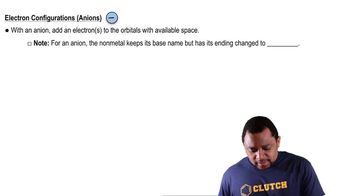The silver oxide–zinc battery used in watches delivers a voltage of 1.60 V. Calculate the free-energy change (in kilo-joules) for the cell reaction
Sketch a cell with inert electrodes suitable for electrolysis of aqueous CuBr2. (b) Indicate the direction of electron and ion flow.
 Verified step by step guidance
Verified step by step guidance
Verified video answer for a similar problem:
Key Concepts
Electrolysis

Inert Electrodes

Ion and Electron Flow

Calculate the standard cell potential and the standard free-energy change (in kilojoules) for the reaction below. (See Appendix D for standard reduction potentials.) <QUESTION REFERENCES APPENDIX D>
Porous pellets of TiO2 can be reduced to titanium metal at the cathode of an electrochemical cell containing molten CaCl2 as the electrolyte. When the TiO2 is reduced, the O2-ions dis-solve in the CaCl2 and are subsequently oxidized to O2 gas at the anode. This approach may be the basis for a less expensive process than the one currently used for producing titanium.
(a) Label the anode and cathode, and indicate the signs of the electrodes.
Porous pellets of TiO2 can be reduced to titanium metal at the cathode of an electrochemical cell containing molten CaCl2 as the electrolyte. When the TiO2 is reduced, the O2-ions dis-solve in the CaCl2 and are subsequently oxidized to O2 gas at the anode. This approach may be the basis for a less expensive process than the one currently used for producing titanium.
(c) Write balanced equations for the anode, cathode, and overall cell reactions.
Classify each of the following unbalanced half-reactions as either an oxidation or a reduction. (b) Pt2+ (aq) → Pt(s)
